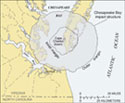|
The Bays Beneath the Bay
April 2011 • Volume 10, Number 1
Michael W. Fincham
The image of a "drowned river valley" has been widely accepted for 80 years as the creation story for Chesapeake Bay, but like evolution theory and big bang theory and other big-picture origin stories, it leaves some important questions unanswered. If, for example, the end of the last ice age created the current estuary, then what happened when other ice ages flourished and faded? As earlier glaciers melted, sea levels must have risen then also, flooding earlier river valleys. If so, where were those earlier river channels? more . . .
 It came from outer space. A massive meteoroid, at least 2 miles wide, hurtled toward Earth at 60,000 miles per hour. Upon impact it extinguished life within several hundred miles. Its force: 100 times greater than the entire nuclear arsenal of the world. Tsunami waves crashed on land. Clouds of pulverized debris blocked the sun. Then, acid rain poured. Be thankful you didn't call the Chesapeake Bay home 35 million years ago. more . . .

Engineers building the Bay Bridge left a geological treasure trove. more . . .
Megan Mueller is Maryland's Knauss Fellow for 2011. more . . .
Our documentary chronicles the fall and rise of Bay oysters. more . . . |